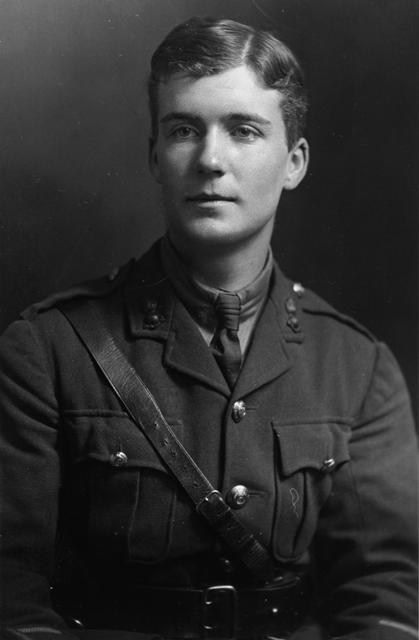
Figure 1. Lieutenant Oswald Camplyon Hutchinson Osmaston, M.C., R.E.
(Image courtesy of the Imperial War Museum)
Lieutenant
OSWALD
CAMPLYON HUTCHINSON OSMASTON, M.C.
Royal Engineers
by
Lieutenant Colonel (Retired)
Edward De Santis, MSCE, PE, MinstRE
(August 2023)

Figure
1. Lieutenant Oswald Camplyon Hutchinson Osmaston, M.C., R.E.
(Image
courtesy of the Imperial War Museum)
1. INTRODUCTION
Like so many other accounts that I have written of the military service of British soldiers who fought in the Great War of 1914-1918, this one ends tragically. Also, like so many other stories, the protagonist is just one member of a family who fought in that war. Lieutenant Osmaston had two brothers who also served, one as an officer in the 3rd Dragoon Guards and another in the Royal Engineers. In addition to the story of the main character of this narrative, the military service of his brother, Brigadier Gordon Hutchinson Osmaston, M.C., R.E. will be summarized in an Annex to this work.
Family Information
Oswald Camplyon Hutchinson Osmaston was born in Southsea, Hampshire on 17 March 1897. He was the second son of Bertram Beresford Osmaston, C.I.E., the Conservator of Forests and the President of the Imperial Forest College and Research Institute in Dehra Dun, India. His mother was Catherine Mary Osmaston, née Hutchinson, the daughter of Major General C.H. Hutchinson, formerly of the Royal Artillery.[1]
Early Life
Oswald Osmaston was educated first at the United Services College in Bognor, Sussex. This was followed by five years at St. George’s School in Harpenden, Hertfordshire and then two years at Cheltenham College in Gloucestershire. He completed his education at the Royal Military Academy in Woolwich where he was awarded the King’s Medal for outstanding achievement in military studies.[2]
3. COMMISSIONING AND TRAINING
Commissioning
Osmaston was commissioned a 2nd Lieutenant in the Royal Engineers from the Royal Military Academy on 28 July 1915.[3]
Training
Following his commissioning 2nd Lieutenant Osmaston was posted to the School of Military Engineering (S.M.E.) at Chatham, Kent for basic officer training. At Chatham he received instruction in field fortifications, construction, surveying, telegraphy, photography, chemistry, military law and tactics. Part of his training was also held at Aldershot. Upon completion of his training he was posted to the 12th Field Company, Royal Engineers, a company with the 6th Division. The company was already in France when he received his orders.
Other units of the Royal Engineers serving with the 6th Division included the 38th Field Company, which transferred to the 28th Division on 7 April 1915, the 1st (London) Field Company, which had joined the 6th Division on 23 December 1914 and was later renamed the 509th Field Company, the 2/2nd (West Riding) Field Company, which had joined on 13 October 1915 and was later renamed the 459th Field Company, and the 6th Division Signal Company.[4]
4. POSTINGS AND CAMPAIGN SERVICE
2nd Lieutenant Osmaston arrived in France in February 1916 when the 12th Field Company was in billets on the Ypres-Poperinghe road. The company moved to Herzeele on 15 March 1916 where it began a period of rest, pontooning and other training. On 27 March the company moved to Calais and it returned to Herzeele on 31 March. From 17 April to 3 June 1916 Osmaston and his company were involved with routine trench work at Boesinghe.
On 4 June 1916 the 6th Division made a limited attack on the German positions near Boesinghe. Osmaston was in command of No. 1 Section of the company, which was detailed to wire in the flank of the division’s objective after it was captured. No. 1 Section’s work was successfully carried out under heavy machine gun fire and in spite of being wounded Osmaston showed great courage and perseverance, remaining at work directing his section until the work was completed the next day. His performance of duty was brought to the attention of Major General C. Ross, the General Officer commanding the 6th Division who wrote the following:[5]
“Your Commanding Officer and Brigade Commander have informed me that you distinguished yourself near Ypres on the night of 3rd-4th June by conspicuous gallantry, coolness and ability when erecting a wire entanglement over 300 yards of very bad ground on the left wing of the attack; also by marking out a trench in the dark and directing the efforts of a digging party of 100 men, all this being accomplished under heavy sniping and machine-gun fire. I have read their report with much pleasure.”
NOTE: The comment above resulted in a Mention in Despatches which was not cited in the London Gazette until 6 February 1921. A curious delay.
Osmaston’s actions at Boesinghe resulted in him being awarded the Military Cross. The citation for his decoration read as follows:
“For conspicuous gallantry, coolness and ability during an attack. He erected wire, marked out trenches in the dark over very bad ground, and directed the efforts of a large working party. All this he accomplished under heavy sniping and machine-gun fire. On a subsequent occasion he was wounded.”[6]
Osmaston’s wound resulted in his evacuation to the U.K. where he was treated and spent about seven months convalescing. Upon his recovery he returned to France on 24 January 1917 and rejoined the 12th Field Company at Beuvry.[7] While he had been recovering from his wound, the 6th Division and his company had been involved in three phases of the Battle of the Somme in 1916:
· The Battle of Flers-Courcelette (15-22 September)
· The Battle of Morval (25-28 September)
· The Battle of Le Transloy (1-18 October)
2nd Lieutenant Osmaston and his section were involved with routine trench work at Beuvry from 25 January to 17 February 1917. On 13 February the company moved to Garbecque and on 25 February operations in the Loos sector began with the company moving to Gonneham. While in the Loos sector during the spring of 1917 the company made numerous moves in support of the division’s operations. These included moves to:[8]
· Bethune on 28 February
· Le Brébis on 1 March (NOTE: On 1 July 1917 while at Le Brébis, Osmaston was promoted to the rank of Lieutenant)
· Labourse on 14 July
· Guestreville on 22 July
Between 15 and 25 August 1917 the 6th Division was involved in the Battle of Hill 70. The 12th Field Company had returned to the front line and the sector was subjected to heavy fire over the whole period, and at first, until trenches had been dug down to normal depth, casualties were heavy.
On 26 August 1917 Lieutenant Osmaston was killed in action in Netley Trench while reconnoitering near Lens. He was killed by a shell on returning through one of the communication trenches after having gone forward to reconnoiter some new trenches. His Section Sergeant, a Sergeant Clarke, and two Sappers were wounded by the same shell.[9]
The Commander Royal Engineers (C.R.E.) of the 6th Division has this to say of Osmaston after his death:
“He was one of the best subalterns I had in the division, and could always be relied on to carry out a difficult or dangerous job thoroughly well. He was very popular with us all and was always so cheerful about his work. He seemed to enjoy being in the trenches, and was quite regardless of danger … and set an example which will always be of use to the men who served under him.”
The Major commanding the 12th Field Company wrote:
“Oswald’s bright, straight and fearless nature had endeared him to everybody. He was always very keen on his work, which he knew thoroughly, and he was void of every particle of fear - the very man to lead a forlorn hope and make a success of it. I considered him the beau ideal of a young British officer, and it is a thousand pities that his promising career should have been cut short. His death is a great loss to the company and to the corps … He died as he lived a brave and very gallant gentleman”
A brother officer wrote:
“It has been a very great blow to us all to lose him like this, and we have lost in him a very gallant officer. He was always cheerful and ready to help anyone, and was a great favourite with both officers and men …. Everyone was very sorry to lose him when he was wounded last year, and all who knew him heartily welcomed him back to the company when he rejoined us …. I have never met a braver officer and the company has suffered an irreparable loss by his death.”
Oswald Camplyon Hutchinson Osmaston, age 20, was buried at Bethune Town Cemetery, Section III, Row J, Grave 15. The inscription on his grave reads:
“ A LITTLE WHILE” ST. JOHN XVI-16
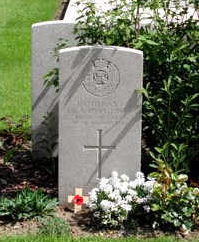
Figure
2. The Headstone of Lieutenant O.C.H. Osmaston, M.C.,
R.E.
(Image courtesy of the Commonwealth War Graves
Commission)
MEDALS, AWARDS AND DECORATIONS
For his service during the war Lieutenant Osmaston was awarded the Military Cross, British War Medal and Victory Medal with Mention in Despatches Oak Leaf.
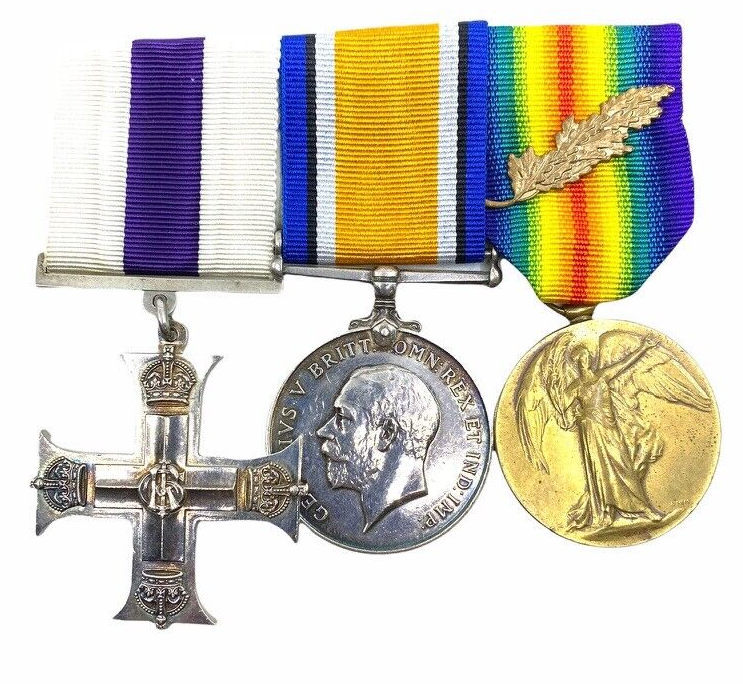
Figure
3. The Military Cross, British War Medal and Victory Medal
with
Mention in Despatches Oak Leaf
(Image from the author’s
collection)
In addition to the medals, Osmaston’s family would have received a bronze Memorial Plaque to commemorate his death in service. The plaque would have contained his name in the box just above the lion’s head, as shown in Figure 4 below. Oswald had a fiancé, Doris Watts, the daughter of Colonel C. D. R. Watts, C.M.G., of Farnborough, Hampshire, to whom he had hoped shortly to be married. However, since they were not married, she would not have been considered to be his next-of-kin and would not have been eligible to receive his medals.
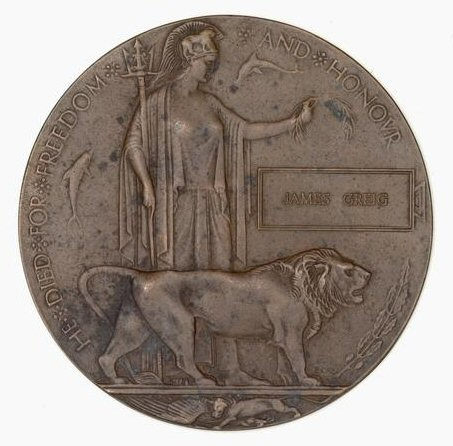
Figure
4. The Memorial Plaque.
(Image from the author’s
collection)
NOTE: Neither the medals nor the plaque are those awarded to Lieutenant Osmaston. They are included here for illustrative purposes only.
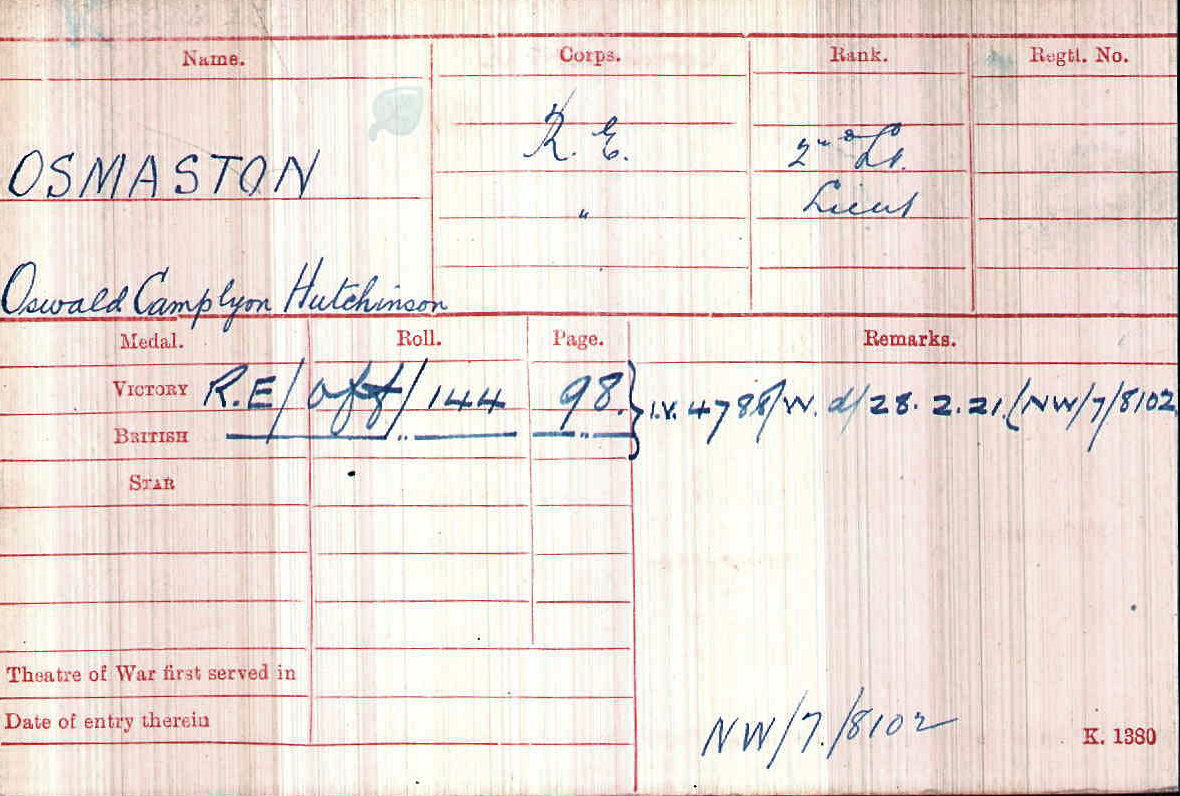
Figure
5. The Medal Index Card of
Lieutenant Oswald Camplyon
Hutchinson Osmaston, M.C., R.E.[10]
(Image
courtesy of Ancestry.com)
ANNEX A
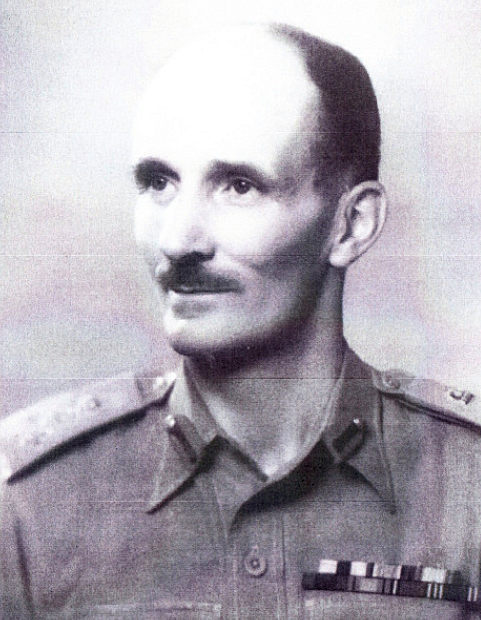
Figure
6. Brigadier Gordon Hutchinson Osmaston, M.C., R.E.
(Image
courtesy of Wikipedia)
Oswald Osmaston had two brothers who served in the Great War. His elder brother was a Lieutenant in the 3rd Dragoon Guards who had served in France from October 1915. His younger brother, Gordon Hutchinson Osmaston, was in the Royal Engineers. All three brothers were in the Regular Army.
Gordon Hutchinson Osmaston was born in India on 26 September 1898. He was educated at Cheltenham College in Gloucestershire and at the Royal Military Academy, Woolwich. He was commissioned as a 2nd Lieutenant from Woolwich on 26 May 1916 and he went to France on 26 March 1918 and served with the 42nd (East Lancashire) Divisional Signal Company, Headquarters, 211th Brigade, Royal Field Artillery and with the Fourth Army Signal Company. He was awarded the Military Cross in 1918 while serving with the 42nd Division.[11]
The citation accompanying his award of the Military Cross reads as follows:
“At Briastre on 20th October, 1918. While acting as signal officer to 42nd Division Artillery, he laid and maintained wire under very heavy shell and machine-gun fire with a complete disregard for his personal safety. He successfully maintained communication with artillery headquarters, which greatly contributed to the complete success of the operation.”
Following the war Gordon was ordered out to India in 1919, and after 2 years in the Third Sappers and Miners he joined the Geodetic Branch of the Survey of India in 1921. He served in Waziristan and with the Survey of India between 1921 and 1948. After 2 seasons abroad he was sent home to complete Engineer training with a year at Cambridge and a year at Chatham.[12]
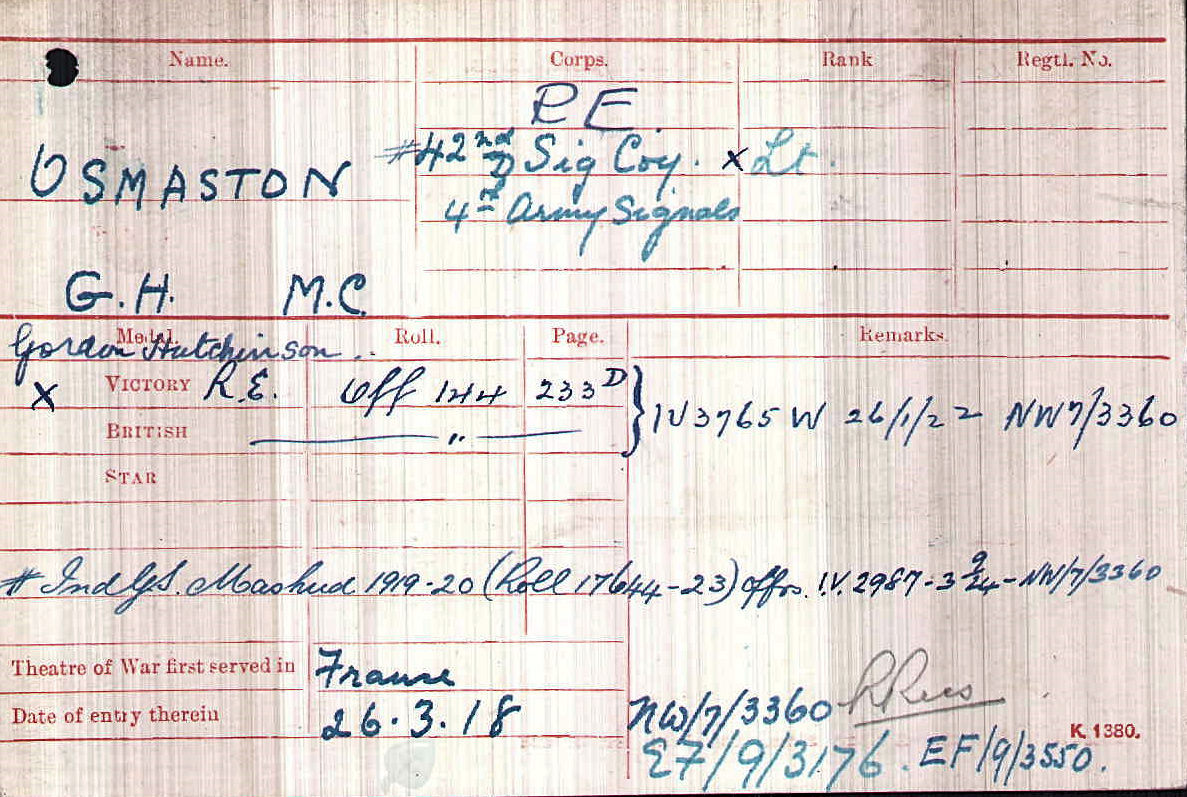
Figure
7. The Medal Index Card of Lieutenant Gordon Hutchinson Osmaston,
R.E.
(Image courtesy of Ancestry.com)
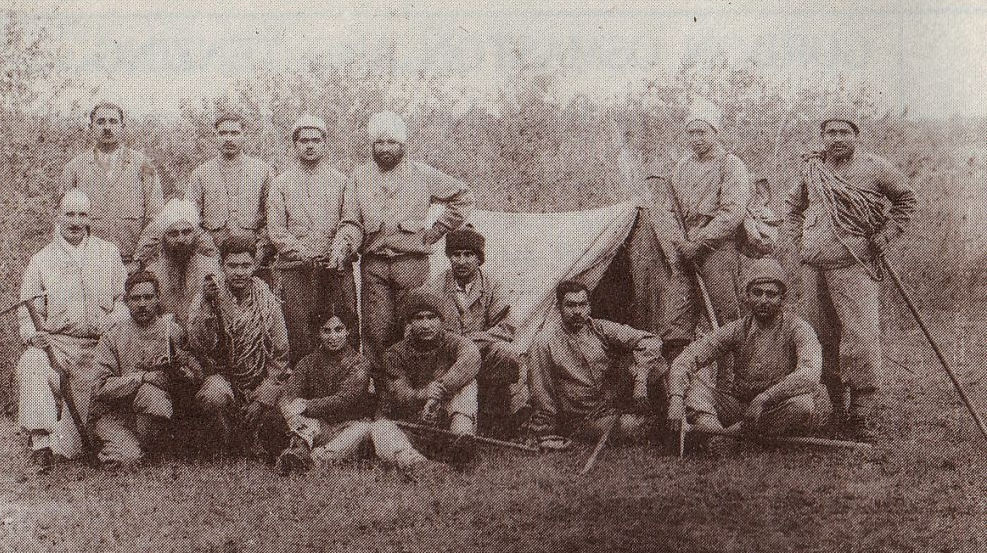
Figure
8. Survey Team in 1936-1937 under Gordon Osmaston (left
kneeling).
(Image courtesy of the Huyton Hill School)
Gordon Osmaston served in Iraq during the Second World War between 1940 and 1941and rose to the rank of Brigadier in the Royal Engineers.
He died in November 1990 at age 92 at Kendal, Cumbria.
ANNEX B
Lieutenant Bertram Hutchinson Osmaston, 3rd Dragoon Guards
Bertram Hutchinson Osmaston was born on 30 March 1895 in Missoorie, India. He was educated at Cheltenham College, Cheltenham, Gloucestershire, and at Oxford University, Oxford, Oxfordshire. He was commissioned a 2nd Lieutenant in the 3rd Battalion of the 3rd (Prince of Wales’s) Dragoon Guards and served in the Great War between 1915 and 1918, when he was severely wounded in 1918 and invalided in 1919. During the war he rose to the rank of Lieutenant.
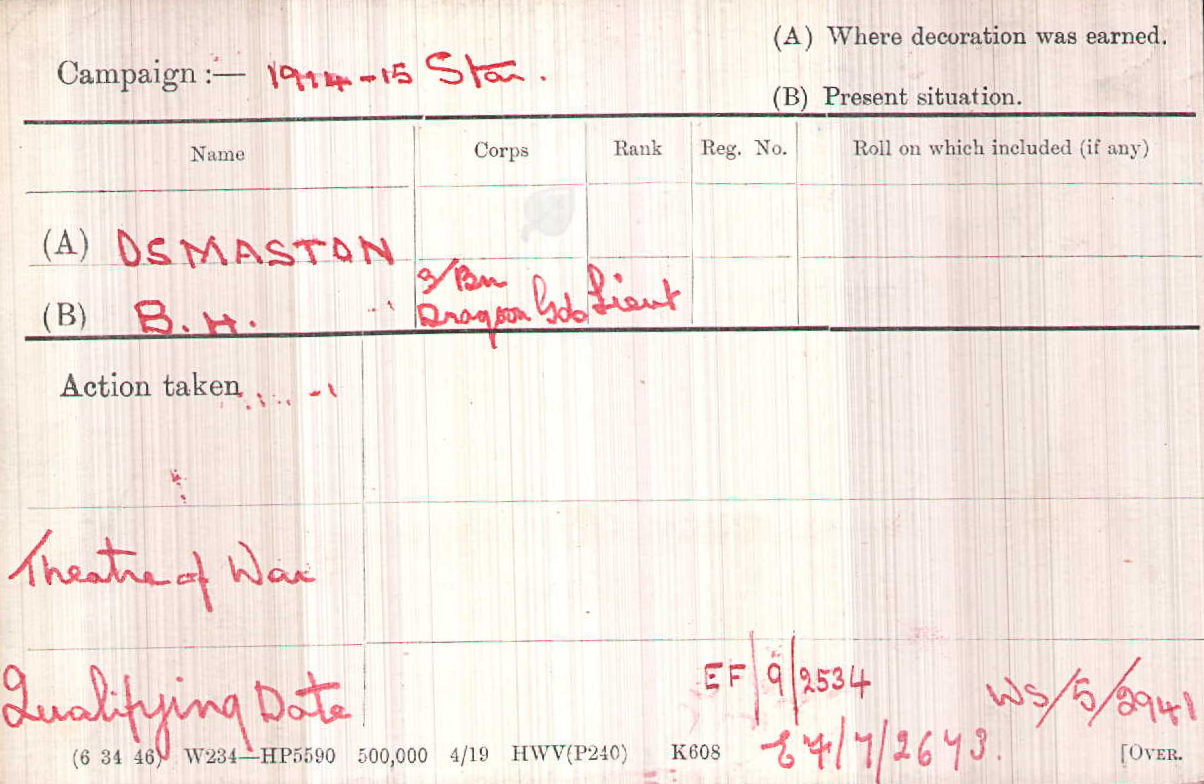
Figure
9a. The Medal Index Card (front) of Lieutenant B.H.
Osmaston, 3rd D.Gs.
(Image courtesy
of Ancestry.com)
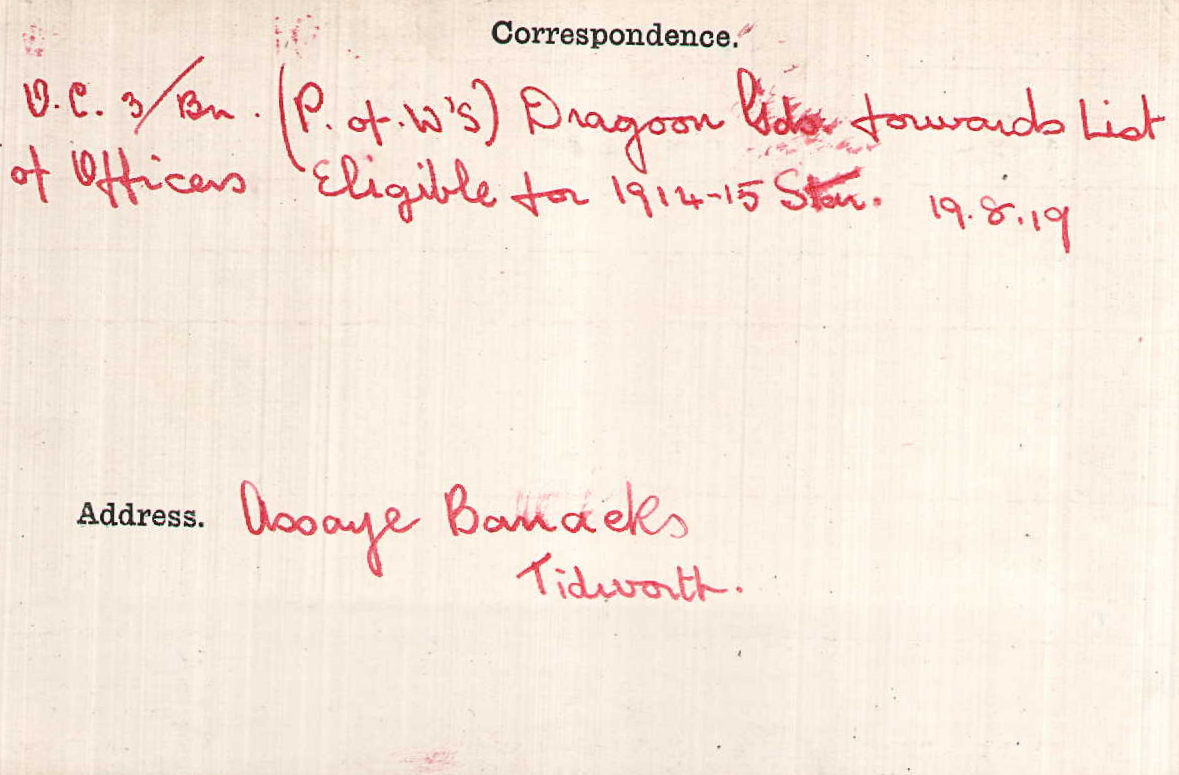
Figure
9b. The Medal Index Card (back) of Lieutenant B.H.
Osmaston, 3rd D.Gs.
(Image courtesy
of Ancestry.com)
ANNEX C
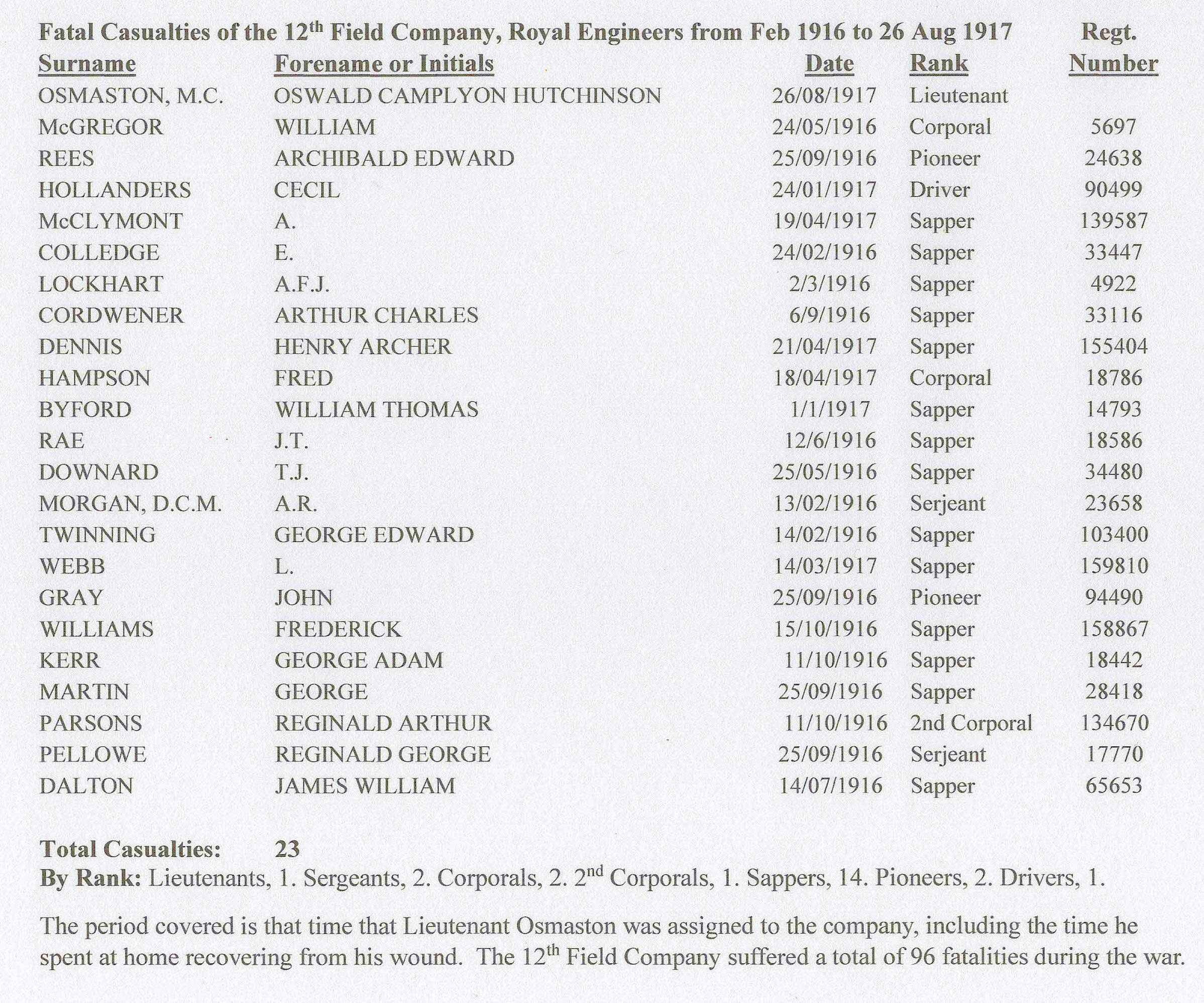
Figure 10. Commonwealth War Graves Commission Data.
REFERENCES:
Books
CALDWELL, M.R. History of the 12th Field Company, Royal Engineers. The Institution of Royal Engineers, Chatham, Kent, 1925.
De Ruvigny’s Roll of Honour, 1914-1918.
Internet Web Site
Commonwealth War Graves Commission.
The Long, Long Trail: History of the 6th Division.
https://www.longlongtrail.co.uk/army/order-of-battle-of-divisions/6th-division/
Huyton Hill School.
https://sites.google.com/site/huytonhillschool/gordon-osmaston
London and Edinburgh Gazettes
The London Gazette, 27 July 1915, pp. 7335 and 7336.
Supplement to the London Gazette, 25 May 1916, p. 5184.
Supplement to the Edinburgh Gazette, 31 July 1916, p. 1324.
Supplement to the London Gazette, 17 September 1917, pp. 9626 and 9627.
Supplement to the London Gazette, 8 February 1918, p. 1810.
Supplement to the London Gazette, 8 March 1919, pp. 3236 and 3245.
Supplement to the Edinburgh Gazette, 8 October 1919, p. 3296.
Military Documents
Medal Index Card O.C.H. Osmaston, R.E.
Medal Index Card G.H. Osmaston, R.E.
Medal Index Card B.H. Osmaston, 3rd D.G.
Periodicals
Battle Honours of the Royal Engineers. The Royal Engineers Journal. The Institution of Royal Engineers, Chatham, Kent, 1925-1932.
ENDNOTES:
[1] De Ruvigny Roll of Honour, 1914-1918.
[2] Ibid.
[3] The London Gazette, 27 July 1915, pp. 7335 and 7336.
[4] The Long, Long Trail.
[5] De Ruvigny Roll of Honour, 1914-1918.
[6] Supplement to the Edinburgh Gazette, 31 July 1916, p. 1324.
[7] De Ruvigny Roll of Honour, 1914-1918.
[8] CALDWELL, M.R.
[9] De Ruvigny Roll of Honour, 1914-1918.
[10] The Medal Index Card does not contain all the information normally found on these cards. The Theatre of War and his date of entry into the theatre are not shown. His award of the Military Cross is not shown nor is his date of death. The reverse of the card shows the entry of the Mention in Despatches with the date 6-2-21 and the address of his next-of-kin (no name given) is 116 Banbury Road, Oxford. This appears to have been the family home as late as 1952.
[11] Supplement to the London Gazette, 8 October 1919, p. 3296.
[12] Ibid.